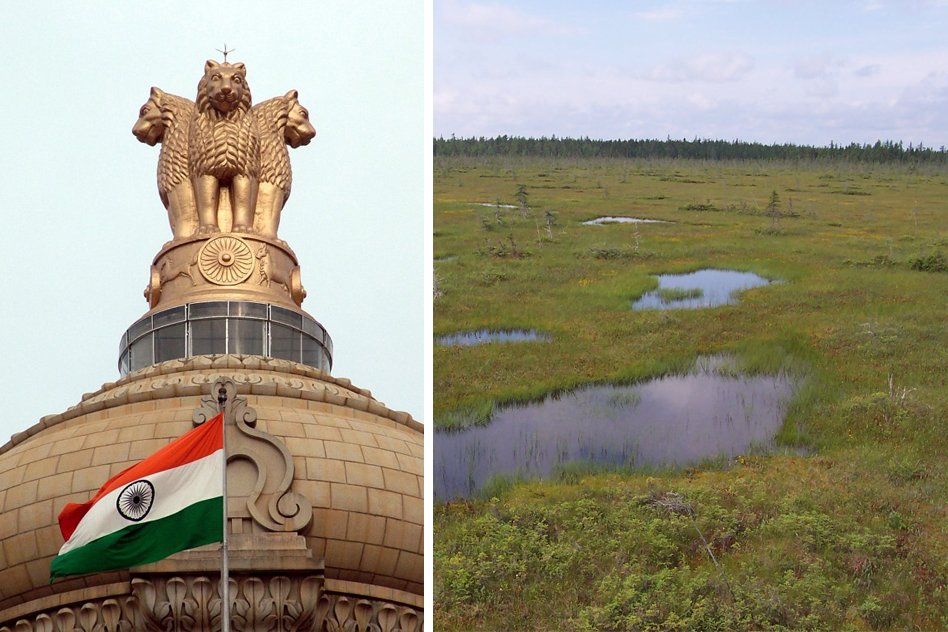
Source: business-standard. Hindustan Times | Image Courtesy: wikimedia, exposeindialive
Central Govt Proposes To Dilute Wetland Protection Rules, It Could Spell Disaster
As the nation is proceeding on the path of development, a plethora of infrastructure projects is on the way. Generally, contradictions arise when natural entities like forests and wetlands come in the way of these projects. At this time, the government has to walk a thin line – balancing the developmental aspirations of the country with its ecological needs. To resolve such deadlocks, it legislates rules and regulations to clearly define how much of the land can be taken for which type of projects.
One such law was enacted in 2010 to protect India’s wetlands. Wetlands are unique ecosystems characterized by a land area saturated with water. They play important roles in water purification, flood control, carbon sink and shoreline stability. Generally, wetlands are home to a diverse nature of plants and animals, like the Sunderbans delta region which is home to the mangroves and the Royal Bengal Tiger. The 2010 regulations notified by the Ministry of Environment, Forests and Climate Change (MoEFCC) sought to identify and protect such wetlands in the country. But recently, these regulations have been taken up for a review by the Central Govt and the changes have been proposed under the draft Wetland (Conservation and Management) Rules, 2016. Let us take a look at the major points given in this draft.
1. Scrapping of the Central Authority
The 2010 regulations had created a central authority of government officers and experts to oversee the protection of wetlands. It gave a fixed time for states to identify and demarcate wetlands, and the process included recommendations and advice of scientific experts at state levels. Some wetlands falling in high altitudes and ecologically sensitive areas, besides the 26 Ramsar Convention sites (wetlands of international importance), were to be automatically given protection.
The proposed regulations have scrapped the central authority of experts and replaced it with a state-level authority headed by the chief minister, including the chief secretary and other state officials. There can be four more people on board, who can be experts or members from the government. The decision of the state based on the recommendations of this authority will be sent to the Centre for approval or rejection. Only the 26 Ramsar wetland sites will get automatic protection.
2. Changes in Definition of Prohibited Activities
The 2010 regulations had prohibited seven types of activities in wetlands, including reclamation of wetlands, setting up of new industries and expansion of existing industries, solid waste dumping, discharge of untreated waste and effluents from industries, and any other construction of permanent nature. For other activities, the regulations required permission from the state government following an environmental impact assessment.
As per the proposed rules, only activities like the reclamation of wetlands and conversion for non-wetland uses, diversion or impediment to natural water inflows and outflows of the wetland and any activity having an adverse impact on the ecological character of the wetlands have been prohibited. This is a non-exhaustive list and looks slightly ambiguous. Further, the rules empower the Centre to allow even these activities without any environmental impact assessment.
3. Absence of stakeholders’ consent
Although not present even in the 2010 draft, the absence of a mechanism to seek the consent of various stakeholders like local communities has been pointed out by some activists. Dr. Latha Anantha, Director of the River Research Centre has termed the approach top-down and bureaucratic and has argued for the inclusion of community leaders and local elected representatives in the newly formed state-authority. Such a clause has already been present in the Scheduled Tribes and Other Traditional Forest Dwellers (Recognition of Forest Rights) Act, 2006, and Panchayats (Extension to Scheduled Areas) Act, 1996. Hence, it should not be a big deal to add a similar provision in the proposed law as well.
On the first look, the new draft does seem like a watered down version of the 2010 regulations. Even the stricter 2010 rules had failed to make all states comply with the laws to notify and protect the wetlands: not even a single wetland has been identified in the country in the last five years. Then how will the newly relaxed laws bring about protection and conservation of our premium natural heritage?
Thankfully, the draft notification is open for public comments till May 31st. The government has also sought suggestions and objections from states.
The Logical Indian urges the readers to give their suggestions to the Ministry of Environment based upon what they think is right. We also request the government to reconsider the draft and make it as less uncompromising as possible, in the interest of our environment and the planet.
 All section
All section













